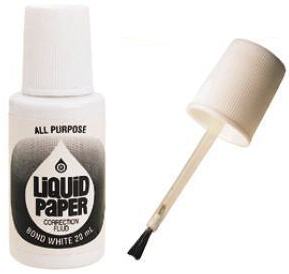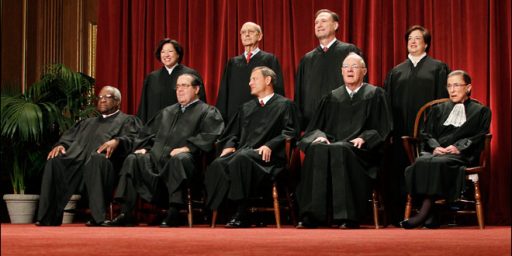Blogging Etiquette: Corrections and Updates
 A drive-by commenter on yesterday’s post about the Sarah Palin wristband faux controversy offered, “If you had any honor you would take the post down.” Aside from the fact that the original post didn’t say what she apparently thought it had and I had supplied three updates further clarifying the situation, I informed her that, “One doesn’t take posts down, one corrects any errors.”
A drive-by commenter on yesterday’s post about the Sarah Palin wristband faux controversy offered, “If you had any honor you would take the post down.” Aside from the fact that the original post didn’t say what she apparently thought it had and I had supplied three updates further clarifying the situation, I informed her that, “One doesn’t take posts down, one corrects any errors.”
Coincidentally, Joy McCann (aka Little Miss Attila) had up a post detailing the blogging guidelines and ethical concerns she’d encountered over the years, noting,
After you’ve posted something, editing should be limited to fixing typos, smoothing out the grammar, and modifying an egregious word choice. Be careful in doing this: once someone quotes your entry somewhere, you’re going to look like an idiot if you’ve edited the passage or the sentence they quote. The most conservative, safe way to edit—and one that you’ll want to use if you find an actual inaccuracy—is to leave the incorrect text there, but crossed out, while adding the new, correct text.
Then, if the error is non-minor, you’ll probably want to place an UPDATE notice at the end, explaining what you did. (For a long entry, or one that’s getting a lot of traffic, you may want to place an UPDATE notice in the headline, so that people will know that there is new information in it.)
Stacy McCain, a career journalist and more recent convert to blogging, demurs.
There is an old adage among English teachers: “Writing is re-writing.” Having learned my craft in the Old School newspaper environment, I’m a bit at odds with the blogger concept that the first draft — the version of the post as it existed when you initially hit the “publish” button — must be preserved inviolate.
My habit is to publish, read over it on the page and then correct typos, etc. I’m thankful for commenters who point out errors, but I seldom acknowledge either the error or its correction in the text of the post, simply because it detracts from the reading experience. The comment pointing out the error remains as acknowledgement of the correction.
My practices on this front have evolved over the years toward something akin to Stacy’s view. Because blogging rewards fast responses, I frequently have minor errors in a piece when it’s published and feel perfectly free to tweak and add to it. This is especially true of “Breaking News” stories. Indeed, when occasion takes me back to archival pieces — sometimes weeks, if not months or years, old — I’ll frequently clean up sentences that were poorly worded, fix spelling errors, and the like.
My rationale is pretty much the same as Stacy’s, too: My object is to present the clearest expression of my thoughts to the reader, not document the writing process. Not only is the latter messy and potentially confusing, almost nobody will care about it.
The exception to this rule is that, for the most part, I’ll acknowledge major errors in fact in the original — either by bracketing the correction inline, using an asterisk or footnote, or appending an UPDATE at the bottom. This is especially true if a commenter or another blogger points out the error.
The etiquette of blogging is that one doesn’t bury one’s errors but rather admits them. (This convention is generally not followed by mainstream media websites. The AP is especially egregious on this front, constantly rewriting stories and changing facts without acknowledgment of that fact.) But the point of this tradition is transparency about facts, not creating a paper trail of minor spelling errors.






James
You probably hate me. However what you said about blog correction is reasonable enough. The issue I have is when someone states an incorrect fact then writes many statements base on that fact then simply post a correction of the underlining fact without doing anything on the many statements. Sorry for the length of that sentence. However I think you get my jest.
It is like the MSM destroying someone’s life that is accused of the crime. Later they are found to be completely innocent then saying they corrected the error by saying he was innocent.
I follow a loose rule closer to Ms McCann’s. If one’s readers can’t be confident that you correct little things, then how can they trust that you’ll be on top of the big things? Inversely, if they catch you making little changes without note, how do they know you’re not making big ones similarly?
Blogging isn’t MSM and MSM isn’t blogging. Both fall somewhere within the rubric ‘journalism’. It’s truly appalling that MSM has insufficient correction mechanism–outside of court ordered corrections, anyway. Far too often, the horse has left the barn before they get around to inside page corrections.
I’ll post an update–actually, repost a piece with UPDATE in the title–if the story is big enough and further developments warrant. If it’s a smaller thing, then I’ll just put an update at the foot of the post, enboldening ‘update’ to make it very visible.
The deletion (or not) of posts is very interesting (if only to me). I wrote about this a couple of years ago and am still not sure there is a “hard rule” that makes sense, especially over the long term (think years or decades).
Tom Ricks seems to have taken a middle course, deleting what he wrote but keeping the post as a bookmark? Sarah Palin’s weird bracelet
I think I was unclear: to me, “fixing typos” includes correcting spelling. And by the time I’ve added “grammar” and “word choice” to the list, I’ve got myself on a pretty long leash.
And nearly no issue of spelling or punctuation is worth issuing an official “UPDATE!” to a blog entry. If I screw up a factual matter, though, I do place an update at the end–and usually a correction in the text itself.
Deleting an entire entry is rarely warranted, and generally frowned upon. I’ve done it a time or two, when no amount of surgery to the text would clarify some garbled, half-baked thought. But I started blogging back when you did, so it hasn’t happened often.
Dude, you got it wrong. They ain’t no etiquette in the rough-and-tumble world of blogs. It’s a Hobbesian nasty, brutish, blogosphere out there, you need to act accordingly–or you’ll get EATEN ALIVE!
Your position seems eminently reasonable, but I would add one thing:
When correcting an error that requires an *UPDATE* it’s a nice gesture to check your trackbacks and leave a comment or fire off an email. Helps your linkers get a jump on any developments and boosts goodwill all ’round.
Hadn’t really thought of it, but a good idea.